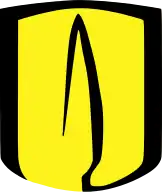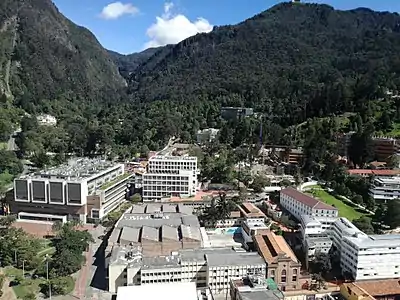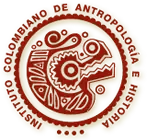University of Los Andes (Colombia)
The University of The Andes (Spanish: Universidad de los Andes), also commonly self-styled as Uniandes,[1] is a private research university located in the city centre of Bogotá, Colombia. Founded in 1948 by a group of Colombian intellectuals led by Mario Laserna Pinzón, it was the first Colombian university established as nonsectarian (independent from any political party or religious institution).[2][7] Los Andes has consistently been regarded as the best Colombian university and has been considered one of the top 5 Latin American universities and one of the top 250 world universities, according to both the QS World Top University Ranking and the Times Higher Education Classification.[8] [9]
Universidad de los Andes | |
 | |
| Type | Private |
|---|---|
| Established | November 16, 1948[2] |
| Affiliation | Nonsectarian |
| Rector | Alejandro Gaviria Uribe[3] |
Academic staff | 1,457a |
Administrative staff | 2,416[4] |
| Students | 24,653b |
| Undergraduates | 14,337[4] |
| Postgraduates | 2,515[4] |
| 276[4] | |
Other students | 1,688 (Specialization)[4] 7,677 (Continuing education)[4] |
| Location | , 4.601613°N 74.065173°W |
| Campus |
|
| Colours | Black and Yellow |
| Nickname | Uniandes |
| Affiliations | Universia,[6] Asociación Colombiana de Universidades |
| Mascot | Séneca the Goat |
| Website | www |
| a This is a sum of 581 FTE professors, 105 faculty developing teachers, and 771 tenured professors.[4] | |
The university is academically composed of nine schools, three special academic entities[10]—the Alberto Lleras Camargo School of Government, the Center for Research and Training in Education (Spanish: Centro de Investigación y Formación en Educación, CIFE), and the Interdisciplinary Center for Development Studies (Spanish: Centro Interdisciplinario de Estudios sobre Desarrollo, CIDER)—and a joint academic venture with the medical institution Santa Fe de Bogotá Foundation,[11] offering 31 undergraduate, 18 doctoral, and 38 graduate degree-granting programs[4] in areas of human knowledge such as medicine, engineering, science, law and others.[7][12]
As of 2011, the university had given birth to 128 research groups recognized by Colciencias, most of them in the social sciences, mathematics, physics and engineering.[4] By 2017, the number of groups recognized by Colciencias has increased to 153 research groups. It is one of the few Colombian universities to have received the maximum high quality institutional accreditation by the Colombian Ministry of Education, given in January 2015.[13]
History
Historical context
In 1930, the Colombian presidential elections resulted in the appointment of Liberal party candidate Enrique Olaya Herrera to an office that had been, since 1880, under Conservative control.[14] The latter years of this Conservative Republic were punctuated by events such as the Banana massacre, which may have been a contributing factor to the Colombian Conservative Party's loss of the presidency.[15]

During this new period of Liberal government, known as the Liberal Republic, the administrations of Alfonso López Pumarejo (1934-1938 and 1942–1946) implemented changes intended to modernize the country. Restructuring of higher education, in particular of the National University of Colombia in 1935, agrarian reform in 1936, and general promotion of industrialization resulted in rapid economic changes and growth.[15] According to some estimates, around 50% of existing Colombian corporations in 1945 were founded between 1940 and 1945, promoting the accumulation of wealth and the creation of a new middle class with political interests and international aspirations.[16]:30
However, in order to continue industrial development, there was an urgent need for skilled labor, reflected in the speech given by the Colombian Minister of Education to the Congress of Colombia in 1946:[17]
We have a lack of engineers, architects, physicians, dentists, agronomists, veterinarians, chemists and even lawyers (...) in sufficient quantities to attend to the country's needs, and the only solution lies in the enlargement of the universities... in the creation of a university for the country, that responds to what the country calls for.
— Germán Arciniegas, Memoria del señor Ministro de Educación Nacional, Germán Arciniegas, al Congreso de 1946, Bogotá, 1946
These words echo the suggestions made around 35 years earlier by liberal leader Rafael Uribe Uribe regarding the need for the modernization of the educational system.[16]:35 These intellectual currents were coherent with previous educational developments such as the foundation of the Gimnasio Moderno in 1914.[16]:37:43–50 Amid the political tension and violence caused by the loss of liberal power in the 1946 elections, social unrest, and industrial growth, leftist liberal presidential candidate Jorge Eliécer Gaitán was assassinated on April 9, 1948, in an event that shook the country and was taken by the founders as "the best argument for the foundation of the university".[16]:54
Foundation and early years (1949-1955)
In November 1948, around a year after arriving back in Colombia from Columbia University, accompanied by intellectuals from the elites of both traditional parties, Mario Laserna Pinzón founded the Universidad de los Andes as the first nonsectarian and non-politically affiliated university in Colombia. The main goals with the establishment of the University were to provide Colombia with professionals whose technical knowledge benefited the development of the country, which made it necessary for them to study abroad and bring this knowledge back;[16]:77 and who would become leaders of their nation in the post-war world, facilitated by founders, faculty, and staff occupying important posts in government and institutions.[16]:58 In practice, Uniandes would be modeled after the American university,[16]:110 and its students would receive not only technical but also liberal education, in accordance to the need for the development of the human intellect for a practical, altruistic purpose, as per the Declaration of the Principles of the Founders.[7]
Classes started the 29th of March, 1949, with only 80 students taking courses from a small set of faculties and schools. Of note was the Colegio de Estudios Superiores, or college, which was modeled on the American university college and had the responsibilities of offering classes on Humanities, Spanish, English, Contemporary Civilization, and Colombian Geography & History. Classes belonging to distinct curricula, but not specific to each, such as mathematics for Engineering and Architecture students, were also the responsibility of the college.[16]:67 By the second academic year, in 1950, there were around 400 applications for 110 places of study in Uniandes.[16]:110
Increasing political violence in Colombia during the 1950s did not change the University's stance towards political neutrality, and the inclusion of government representatives in the Board, as well as rectors and administrative staff belonging to both Conservative and Liberal parties, ensured good relations with conservative, military, and liberal Colombian administrations.[16]:83–84
Starting in 1950, the three/two program was established at first with the University of Illinois at Urbana–Champaign.[16]:102 Through it, Uniandes students were able to course 5 semesters, or three years, at home, and then transfer to an American university to complete their undergraduate program. Participating universities included Pittsburgh, MIT, Vanderbilt, and Texas, among others.[16]:103 The funds for tuition expenses in the United States were initially provided by Colombian industries such as Avianca and Paz del Río Steelworks; American philanthropic institutions (the Rockefeller Foundation); and Colombian, Canadian, and American private individuals. To manage these assets, the University hired ICETEX, a government agency established by University founder and then-Minister of Education Gabriel Betancourt, whose objective was to promote Colombian students abroad through grants and scholarships.[16]:104
Throughout the early 1950s, diverse experiments were carried out by the University as per its aspirations to fulfill the needs of its country and become an internationally recognized institution. Some of them failed, such as the Faculty of Aeronautic Sciences, due to low student interest; the Institute for Conservation of Natural Resources, which granted non-professional degrees on its subject matter; and the Preparatory Lyceum of Pereira, intended to equip high school students of this city with the necessary tools to thrive in Uniandes.[16]:112 Important successes were attained by the Cultural Extension Section: the organization of academic conferences whose speakers included the likes of John von Neumann, Arnold J. Toynbee, Hideki Yukawa, Thornton Wilder, and others.[16]:114 The subjects and structure of these conferences would give way to the establishment of the Female Section of the University in 1953, though its programs of study did not confer professional degrees.[16]:115 Active recruitment of foreign professors from abroad and from other Colombian educational institutions, such as the National University, the Normal Superior School, and the Gimnasio Moderno, was also an important strategy for the administrative staff in the initial years of Uniandes.[16]:116
Mission
The University of Los Andes states that it is “an autonomous, independent, and innovative institution that fosters pluralism, tolerance, and respect for ideas; it seeks academic excellence and imparts to its students a critical and ethical training to strengthen their awareness of their social and civic responsibilities, as well as their commitment to the environment.”
Staff
As of 2014 Los Andes' faculty members were mainly full-time academics, of whom 70% had a PhD from a top university in the world. Los Andes has traditionally supported instructors in undertaking their master's and PhD studies in different subject areas in renowned foreign universities.
Student population
- 55% male, 45% female
- 30% come from outside Bogotá
- 95% of the undergraduate students come from the top 1% of the high school students in the country
Academic structure
.jpg.webp)
Students can register in classes from all academic programs offered at Los Andes; this interdisciplinary approach allows students to design their own curricular program, with the assistance of academic advisors. The following scheme shows the academic structure at Uniandes, which includes four cycles: a Basic Professional Cycle (CBP, in Spanish), which refers to the basic subjects belonging to each program; a Cycle of Elective Courses in Socio-humanistic issues (CSH, in Spanish), common to all programs and that offers about 180 courses; a Professional Cycle (CP, in Spanish), which includes the main professional subject for each program; and a Professional Complementary Cycle (CPC), which includes subjects from the specific program and subjects from other programs.
International students
International students can attend the university as visiting students, who must be enrolled in at least three courses per semester, or exchange students, who can take between two and six courses per semester. Los Andes has academic exchange programs with more than 119 universities in 34 countries worldwide.
Campus

Uniandes started academic activities in terrains rented from the Community of the Good Shepherd, a religious institution, and would continue to do so for around five years before buying the first plots of land, with a size of approximately 0.025 square kilometers. Included in the purchase were several buildings that were used by the religious community, such as a convent and a prison for women. Due to the low university population, the existing buildings were mostly restored and conditioned to provide adequate facilities for academic activities.
The campus is largely made up of a mixture of renovated industrial and religious buildings and newly constructed facilities. The infrastructure covers 180,551 sq mt and includes approximately 116 classrooms, 219 laboratories, a central library, and five satellite libraries (specialized by areas), were more than 445,000 books are available for students. It also has 26 computer rooms and six service units that hire out laptops, offering nearly 2,000 computers for student use (16.5 computers for each 100 students). As of 2017, there are 3,019 computers available for student use in the computer rooms.
In 1956 a metallic cylindrical structure now known as La Caneca (the Trash Bin) was installed on campus. La Caneca is the sports center of the university and it is composed of a gym, a pool, and various courts for sports like tennis, squash, and football.
The university's campus is in Bogota's historical center, an area that houses most of the city's buildings of cultural interest, universities, banks, and large Colombian companies; the main offices of the national and local government; and a variety of cultural meeting places, such as libraries, museums, theatres, scientific and literary centers, and art galleries.
Also on campus are:
- Central cafeteria and many other food stations inside and outside the campus
- Gym and sports facilities
- Health services
- Rest and study areas
In addition to the main campus, the university also has an Internships Center for the Medicine Faculty, located at the Fundación Santa Fe de Bogotá, in the northern part of the city. Uniandes and Fundación Santa Fe—one of the most renowned medical institutions in the country—engage in a joint academic venture.
University rankings
Universidad de los Andes has been consistently ranked as the best university in Colombia and has been considered one of the top 5 Latin American universities and one of the top 250 in the world.
| University rankings | |
|---|---|
| Global – Overall | |
| QS World[18] | 234 (2020) |
| THE World[19] | 261 |
| Regional – Overall | |
| QS Latin America[20] | 5 |
| THE Latin America[21] | 5 |
Organization and structure
The university has a Board of Directors, an Executive committee, a Rector, and three Vice Rectors, for academic and administrative management. It also has a General Secretary, an Academic Council, department deans and coordinators, Faculty Councils, academic and administrative staff and departments for the smooth operation of the institution.
Mascot
The mascot of Uniandes is a goat called Seneca, after the Roman Stoic philosopher. Its story dates back to the late 1940s when a goat roamed the campus freely. Students adopted it, and it soon became a symbol of the university. The goat died in 1966 when it fell off a cliff. Today it is not possible to keep a goat on campus, but Seneca is fondly remembered. The wireless spots are named after the goat, and every year a goat is brought to the university to celebrate "Students' Day."
Notable alumni
- César Gaviria – President of Colombia from 1990 to 1994 and Secretary General of the Organization of American States (1994-2004)
- Alejandro Gaviria Uribe – Former 3rd Minister of Health and Social Protection of Colombia
- Andrea Echeverri - Musician, lead singer of alternative rock band Aterciopelados
- Patricia Cardoso - Filmmaker
- Juan Carlos Echeverry (politician) – Former CEO of Ecopetrol and was the 68th Minister of Finance and Public Credit of Colombia
- María Ángela Holguín – Former Minister of Foreign Affairs, formerly the 25th Colombian Ambassador to the UN and Ambassador to Venezuela
- John Horvath – Hungarian-American mathematician noted for his contributions to analysis
- Rafael Pardo Rueda – Former 1st Minister of Labour of Colombia and formerly member of the Colombian Senate
- Maria Fernanda Cardoso - Artist
- Carlos Rodado Noriega – Former Colombia Ambassador to Argentina, formerly 28th and 9th Minister of Mines and Energy of Colombia, Ambassador to Spain and member of the Chamber of Representatives of Colombia
- Sergio Fajardo – Former Governor of Antioquia (2012-2016) and mayor of Medellin (2004-2007)
- Simón Vélez – Prize-winning architect known for his innovative use of bamboo as an essential building component
- Luis Caballero (painter) – Famous Colombian painter
- Paola Turbay – Colombian-American actress and former Miss Colombia (1992)
- Gabriela Tafur –Miss Colombia (2018)
- Ana Maria Rey – Colombian theoretical physicist awarded the Genius Grant by the MacArthur Foundation for her research on ultra-cold atoms (1999)
- Helena Groot de Restrepo - Professor, microbiologist, geneticist
References
- "Manual de Identidad Visual" [Visual Identity Manual] (PDF) (in Spanish). Communications Office of Los Andes University. Archived from the original (PDF) on 2012-10-24. Retrieved December 11, 2012.
El símbolo de la Universidad de los Andes es el escudo. (The symbol of Los Andes University is the Shield).
- "Historia - Información General" [History - General Information] (in Spanish). Los Andes University. Retrieved December 11, 2012.
- "El Rector" [The Rector] (in Spanish). General Secretariat of Los Andes University. Retrieved December 11, 2012.
- "Boletín Estadístico 2020 Universidad de los Andes, 1,910 (2011)" [2020 Statistical Bulletin, Los Andes University] (PDF) (in Spanish). Office of Planning and Evaluation of Los Andes University. Retrieved December 11, 2012.
- "Areas". Los Andes University. Retrieved December 11, 2012.
- "Universidades" [Universities] (in Spanish). Universia. Archived from the original on 2013-05-13. Retrieved December 11, 2012.
- "Estatutos Vigentes 2011" [Current Statutes 2011] (PDF) (in Spanish). General Secretariat of Los Andes University. Retrieved December 12, 2012.
- "University of the Andes". QS World University Rankings. Retrieved June 5, 2020.
- "University of the Andes". Times Higher Education. Retrieved December 13, 2012.
- "Organigrama" [Organizational Structure] (PDF) (in Spanish). Los Andes University. Retrieved December 12, 2012.
- "Pregrado - Fundación Santa Fe de Bogotá" [Undergraduate Program - Santa Fe de Bogotá Foundation] (in Spanish). Los Andes University. Archived from the original on 2016-03-03. Retrieved December 12, 2012.
- "Programas" [Programs] (in Spanish). Los Andes University. Retrieved December 12, 2012.
- "Instituciones de Educación Superior Acreditadas - Consejo Nacional de Acreditación" (in Spanish). Archived from the original on September 9, 2004. Retrieved 2009-02-26.
- Orlando, Melo González, Jorge. "La República conservadora. (La situación colombiana hacia 1880, La guerra, la paz y las constituciones, La expansión de la económica cafetera, La danza de los millones y el fin del régimen conservador, lecturas adicionales) | banrepcultural.org". www.banrepcultural.org (in Spanish). Retrieved 2017-09-14.
- Bushnell, David (2007). Colombia, una nación a pesar de sí misma (in Spanish). Bogotá: Planeta. pp. 216–315.
- Bell Lemus, Gustavo (2008). Historia de la Universidad de los Andes, v. 1. Inicios 1948-1977 (in Spanish). Bogotá: Ediciones Uniandes.
- Memoria del señor Ministro de Educación Nacional, Germán Arciniegas, al Congreso de 1946 (in Spanish). Bogotá. 1946.
- QS World University Rankings 2020
- World University Rankings 2018
- http://www.topuniversities.com/university-rankings/world-university-rankings/2020#sorting=rank+region=+country=+faculty=+stars=false+search=. Missing or empty
|title=(help) - Latin America University Rankings 2016
External links
- (in Spanish) Universidad de los Andes website

